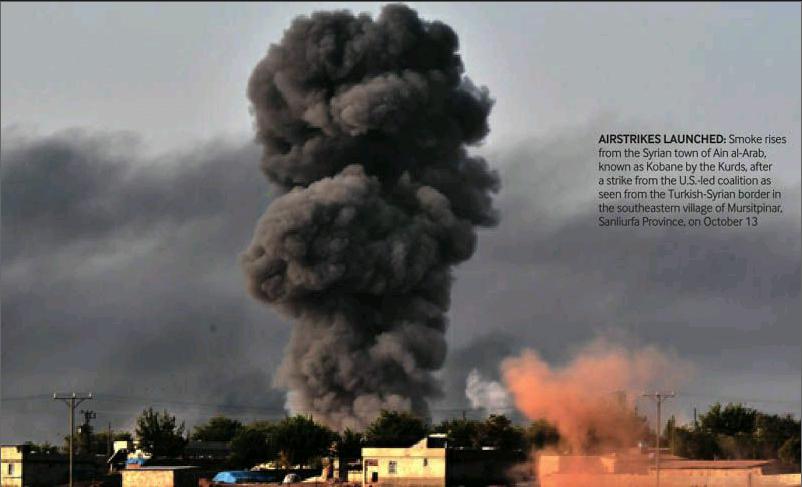Steep Obstacles
2014-12-01ByLiWei
By+Li+Wei

The Islamic State (IS) militant group has shown its extremely brutal face to the world in its attacks and occupation of many cities and towns in Iraq and Syria in the past months. The unstoppable offensives of the IS have directly threatened the strategic interests of the United States in the Middle East.
Despite a slow reaction at first, the United States finally announced the launch of airstrikes against the IS on August 8 and President Barack Obama outlined a comprehensive strategy to combat IS militants on September 10. Up to now, however, the anti-IS actions have not yielded the expected results.
The rise of the IS is not an accidental or isolated phenomenon. The Iraqi Government failed to implement effective governance after the United States withdrew troops from the turbulent country at the end of 2011, creating a large security vacuum. In addition, its three-year civil war has made Syria a haven for Islamist extremists. The IS exploited the chaos in the region and grew rapidly. It has now become the primary terrorism threat since the notorious Al Qaedas leader Osama bin Laden was hunted down and killed by a U.S. task force in Pakistan in 2011.
The IS has claimed that it was formerly the Iraqi division of Al Qaeda, also known as Al Qaeda in Iraq (AQI). Despite their defeat by U.S. troops, it recruited followers from all over the world secretly and prepared for resurgence. After Syria fell into civil war, AQI expanded into Syria and fought as a rebel militant group against the regime of Syrian President Bashar al-Assad. AQI occupied many places and developed a strong and experienced army.
In April 2013, AQIs head Abu Bakr al-Baghdadi announced the formation of the Islamic State of Iraq and the Levant, or the Islamic State in Iraq and al-Sham.
In June, al-Baghdadi announced the establishment of a caliphate, of which he was named caliph, to be known as Caliph Ibrahim, and the Islamic State of Iraq and the Levant was renamed the Islamic State.
The IS has become a strong military group with over 10,000 militants. Most of these militants are the veterans of battles in Iraq and Syria and have rich experience in launching terrorist attacks and fighting in guerilla warfare.
Al-Baghdadi, around 40 years old, is adept at military command. Under his command, the IS has adopted extreme and horrific methods to reach its goals, making it a far for fearsome group than Al Qaeda. In addition to terrorist attacks such as car bombings and abductions, they eliminate and persecute followers of other religions and sects by any means necessary, massacring captives of war and frightening those who dare to oppose and resist. These tactics have helped the IS occupy large areas in Iraq and Syria.
More importantly, al-Baghdadis army is backed with sufficient funds from a variety of revenue sources in their occupied lands, gained from activities such as by imposing protection money schemes on stores and merchants. For example, the total protection money collected by IS militants in Mosul, capital city of north Iraqs Nineveh Governorate, reportedly reaches as high as $8 million per month.
Since 2012, the IS has engaged in selling oil and smuggling historic relics in its occupied area in Syria. To make quick money, IS militants also conduct abductions and bank robberies. Donations from a number of Sunni merchants comprise another important source of IS funds.
IS militants robbed $425 million from the central bank of Mosul and obtained over 400,000 pieces of arms and ammunition that belonged to Iraqi security forces after a battle last June, The Guardian reported on June 25.
The IS has become the worlds richest terrorist organization. According to an Iraqi official, the organization possessed as much as $875 million in capital and assets before it controlled Mosul. After robbing local banks and military bases, the total assets of the IS may have increased to $2 billion. With such economic strength, not only can the IS enlarge its army in Syria and Iraq, but it can also provide funds for other terrorist groups, expanding its influence in the world.
An arduous task
Ever since the Obama administration announced its airstrike campaign against the IS, many have questioned whether such a task could succeed.
After the September 11 terrorist attacks in the United States in 2001, then-U.S. President George W. Bush unleashed a war on terror in Afghanistan in late 2001. Two years later in 2003, the Bush administration expanded the war to Iraq, which opened a Pandoras box of conflicts and discord. The Iraq war deeply undermined regional security in the Middle East and intensified hatred of Muslims toward the United States and its allies.
Since assuming power, Obama has made an extensive adjustment on U.S. counter-terrorism strategy and even dropped the term “war on terror.” Instead, it prefers more tactical approaches, for example, sending drones and task forces to support allies in the fight against terrorist organizations. In order to improve ties with Islamic states, Obama has stressed repeatedly that fighting against terrorism is not an attack on Islam and the major counter-terrorism task of the United States in the Middle East is to fight against divisions of Al Qaeda.
The IS developed its army in the Syrian civil war, which initially did not arouse the attention of the Obama administration. When the IS launched an offensive back into Iraq, Obama did not roll out a plan promptly owing to differing domestic opinions. Many politicians did not regard the IS as a direct threat to U.S. interests. Furthermore, there was a strong calll for U.S. troops to not be dragged into another war. Under such circumstances, the Obama administration did not offer military aid promptly as Iraqi Prime Minister Nouri al-Maliki requested.
Even though Obama announced airstrikes against the IS on August 8, he was not willing to allow the United States to fight a deep battle with the IS, stressing a limited military engagement. After two American journalists were killed by IS militants and the IS threatened to retaliate against U.S. targets, Obama eventually rolled out a strategy on September 10, including expanding airstrikes to Syria, offering aids to Iraqi security forces and Kurdish troops, raising a “moderate”rebel army in Syria, as well as teaming up with other countries to fight against the IS.
The airstrikes have lasted over two months, but the IS has not been fatally wounded. Moreover, they have at some points set back the offensive of the Iraqi army on the ground. It is reported that the IS appears to be building an air force. In any case, the U.S. plan to fight the IS has run into steep political and military obstacles.
The Obama administration lacks a comprehensive and long-term strategy against the IS threats. The current plan is more likely a temporary solution. The IS is deeply rooted in Iraq and Syria. It is unlikely to be defeated completely by airstrikes and a weak Iraqi army in the short term, without the strong support of U.S. combat troops on the ground and a comprehensive strategy encompassing diplomatic, intelligence, economic and political fronts. Obama, however, has stated that there will not be a ground battle.
In recent years, Obama has been focusing on ending wars in Iraq and Afghanistan and pivoting to the Asia-Pacific region. Apart from the Middle East, the United States must watch out for other terror threats around the world, such as Khorasan, a group of senior Al Qaeda members who operate in Syria, that some U.S. officials said may be even more dangerous than the IS in some respects. For this reason, the Obama administration cannot throw itself into the fight against the IS.
The collaboration of the international counter-terrorism alliance is another challenge. Until now, only a small number of Western countries agreed to join in airstrikes against the IS. Despite unified support from Arabian allies, they have relatively limited military strength. Iraqi security forces should be the principal force, but its combat effectiveness has been weakened largely by internal religious conflicts and corruption.
In view of these facts, U.S. General John Allen, Obamas special envoy for coordinating international actions against the IS, called on U.S. allies to contribute more on October 27.
The Obama administration has excluded the possibility of cooperating with Iran and Syrian President al-Assad on fighting against the IS. Indeed, the White House has called on al-Assad to step down. Despite no direct intervention in Syria, the Obama administration expects the rebel army can overthrow the regime of al-Assad. In his strategy, Obama plans to raise a 15,000-strong rebel army in Syria to fight against the IS. But rebel leaders in Syria say that they would reject joining a U.S.-backed force that is not aimed at defeating al-Assad, their main enemy.
Fighting against the IS is an asymmetric war. With the current strategy, the Obama administration cannot reach its goal in the short run. As Al Qaedas influence spreads in South Asia, the United States may be faced with even more severe terror threats.
